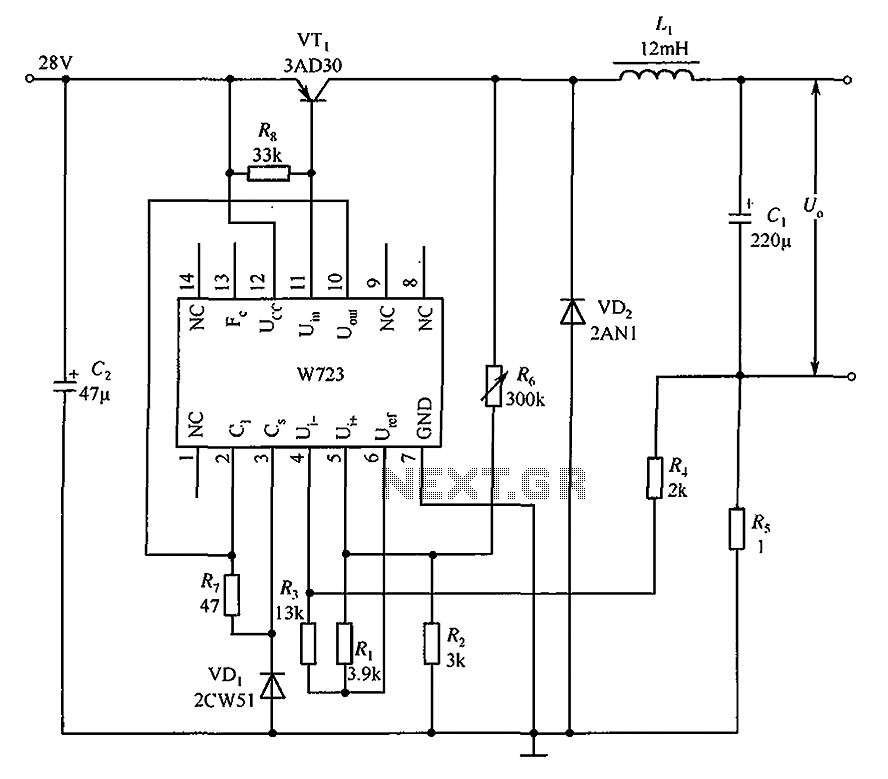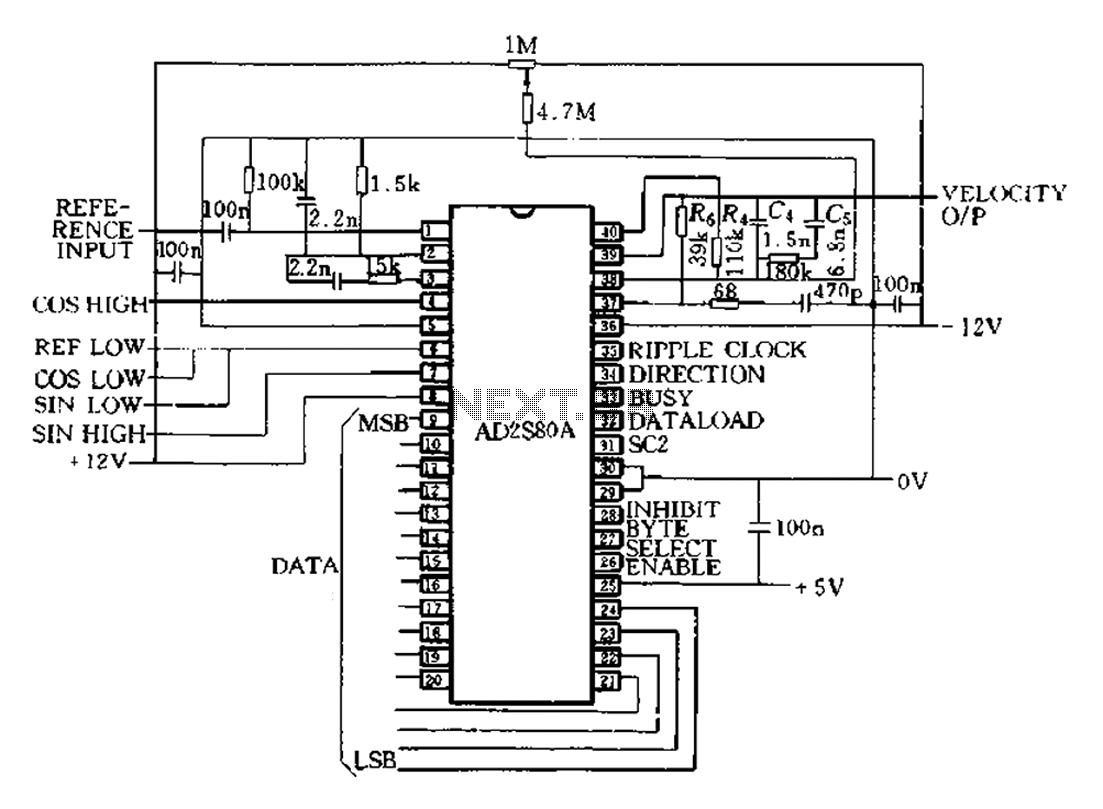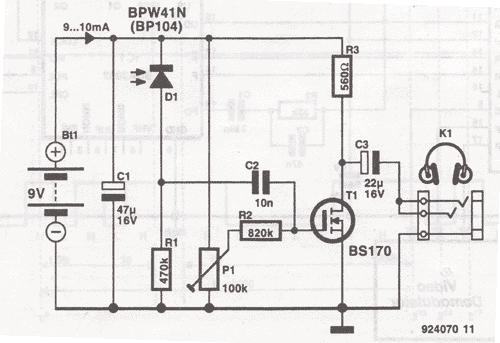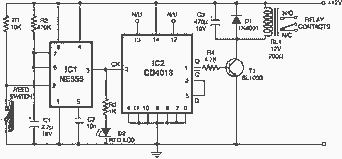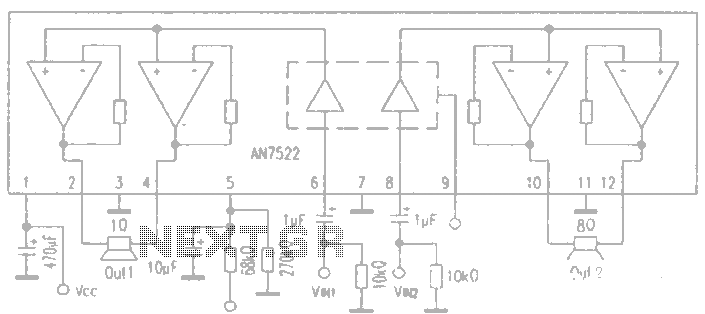
Door bell circuit using NE555
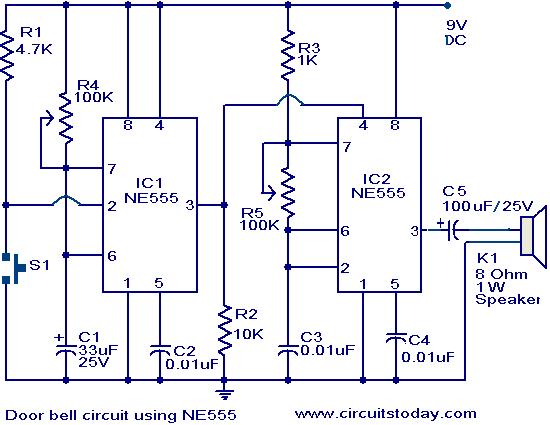
The primary components of this doorbell circuit are two NE555 timer integrated circuits (ICs). When switch S1 is pressed momentarily, the loudspeaker emits a bell tone for the duration determined by the monostable multivibrator configuration around IC1. Pressing switch S1 triggers IC1 at pin 2, causing the output at pin 3 to go high for a time period set by the values of potentiometers R4 and R5. When the output of IC1 goes high, it resets IC2, which then begins to oscillate, producing a bell sound through the speaker. IC2 is configured as an astable multivibrator, with its oscillation frequency adjustable via potentiometer R5. By modifying the values of R4 and R5, the tone can be altered. For those unfamiliar with the fundamentals of the 555 timer IC and its applications, various resources are available for purchase that provide comprehensive insights.
The circuit employs two NE555 timer ICs to create a functional doorbell system. The first timer, configured in monostable mode, is activated by pressing switch S1. This action triggers the timer, causing the output at pin 3 to go high, which energizes the loudspeaker for a duration determined by the resistor-capacitor (RC) time constant established by R4 and the timing capacitor. The output duration can be fine-tuned by adjusting the potentiometer R4.
Once IC1's output transitions high, it resets the second timer, configured in astable mode. This configuration allows IC2 to continuously oscillate, generating a square wave output that drives the speaker, producing a bell sound. The frequency of the oscillation, and thus the pitch of the bell tone, can be varied by adjusting potentiometer R5. This flexibility enables users to customize the audible alert according to their preferences.
The circuit's design showcases the versatility of the NE555 timer ICs, which are widely used in various applications due to their reliability and ease of use. For individuals seeking to deepen their understanding of the 555 timer and its applications, several educational resources are available, including reviews of notable books that cover 555 timer circuits and projects in detail. These resources can serve as valuable tools for enhancing knowledge and practical skills in electronics.The main part of this doorbell circuit are two NE555 timer ICs. When some one presses switch S1 momentarily, the loud speaker sounds a bell tone as long as the time period of the monostable multivibrator built around IC1. When the switch S1 pressed, IC1 is triggered at its pin 2 and output pin 3 goes high for a time period previously set by the val
ues of POT R4 and POT R5. When the output ofIC1 goes high it resets IC2 and it starts to oscillate to make a bell sound through the speaker. The IC2 is configured as an astable multivibrator whose oscillation frequency can be varied with the help of POT R5.
By adjusting the values of R4 & R5, modifications on the tone are possible. If you are not familiar with the basics of 555 timer IC, and its applications, you can buy books that will help you get a better understanding from our online store. Totally 3 books have been reviewd in detail along with their authors. You can get their reviews and buy them here:- 3 Great Books to Learn 555 Timer Circuits and Projects 🔗 External reference
The circuit employs two NE555 timer ICs to create a functional doorbell system. The first timer, configured in monostable mode, is activated by pressing switch S1. This action triggers the timer, causing the output at pin 3 to go high, which energizes the loudspeaker for a duration determined by the resistor-capacitor (RC) time constant established by R4 and the timing capacitor. The output duration can be fine-tuned by adjusting the potentiometer R4.
Once IC1's output transitions high, it resets the second timer, configured in astable mode. This configuration allows IC2 to continuously oscillate, generating a square wave output that drives the speaker, producing a bell sound. The frequency of the oscillation, and thus the pitch of the bell tone, can be varied by adjusting potentiometer R5. This flexibility enables users to customize the audible alert according to their preferences.
The circuit's design showcases the versatility of the NE555 timer ICs, which are widely used in various applications due to their reliability and ease of use. For individuals seeking to deepen their understanding of the 555 timer and its applications, several educational resources are available, including reviews of notable books that cover 555 timer circuits and projects in detail. These resources can serve as valuable tools for enhancing knowledge and practical skills in electronics.The main part of this doorbell circuit are two NE555 timer ICs. When some one presses switch S1 momentarily, the loud speaker sounds a bell tone as long as the time period of the monostable multivibrator built around IC1. When the switch S1 pressed, IC1 is triggered at its pin 2 and output pin 3 goes high for a time period previously set by the val
ues of POT R4 and POT R5. When the output ofIC1 goes high it resets IC2 and it starts to oscillate to make a bell sound through the speaker. The IC2 is configured as an astable multivibrator whose oscillation frequency can be varied with the help of POT R5.
By adjusting the values of R4 & R5, modifications on the tone are possible. If you are not familiar with the basics of 555 timer IC, and its applications, you can buy books that will help you get a better understanding from our online store. Totally 3 books have been reviewd in detail along with their authors. You can get their reviews and buy them here:- 3 Great Books to Learn 555 Timer Circuits and Projects 🔗 External reference
Warning: include(partials/cookie-banner.php): Failed to open stream: Permission denied in /var/www/html/nextgr/view-circuit.php on line 713
Warning: include(): Failed opening 'partials/cookie-banner.php' for inclusion (include_path='.:/usr/share/php') in /var/www/html/nextgr/view-circuit.php on line 713
